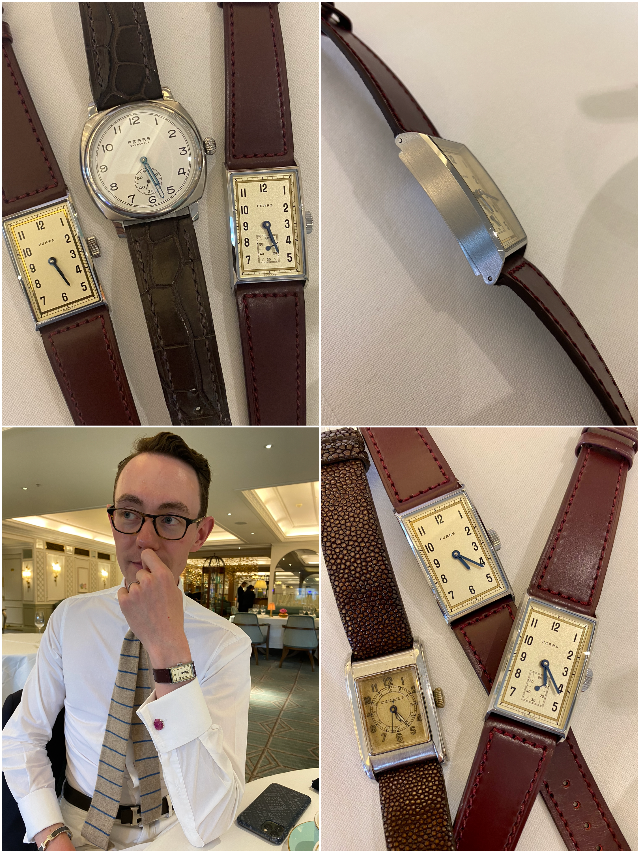 |
| One of the two new Fears Archival watches |
I was able to look closely at the two watches recently and was impressed by the quality of the finish of dial and case. They are launched at a time when rectangular watches seem to be sought after among watch lovers. While vintage in character, there is something very contemporary about the simplicity of their styling.
I was wearing a 1930s Jaeger LeCoultre when I met Nicholas Bowman-Scargill, head of Fears, recently to see the new watches. I wasn't previously aware of their rectangular shape and it was coincidental that I was wearing a similar watch, but the fact that I was doing so was illustrative of the recent rise in popularity of the shape, evidenced by interest in rectangular timepieces such as the Jaeger LeCoultre Reverso, Cartier and others.
 |
| Fears Archival watches with '30s Jaeger LeCoultre and Fears's Nicholas Bowman-Scargill |
The curved profile case of the Fears Archival watch is machined from 316L stainless steel and preserves the proportions of, while being slightly larger than, the 1930s original. A ‘Vintage Champagne’ dial is set off by a contrasting polished 18ct yellow gold border and crisp black Art Deco-style numerals and minute track. The simple blued hands are solid versions of the ‘Fears’ shape watch hands and feature a central bevel with diamond polishing on either side.
All the sizes and proportions have been carefully thought out and tweaked in order to achieve just the right appearance. In watch design it's remarkable how even tenths of a millimetre can make a discernible difference to a watch's appearance and it wasn't simply a case of scaling up from the slightly smaller vintage original (see the image below).
 |
| The 1930s original Fears (left) alongside the two new models (not exactly to scale) |
Each watch has a vintage-style handmade Oxblood Red calf leather strap tanned in Bristol by Thomas Ware & Sons, Britain’s oldest vegetable tanner who created the leather for Fears’ watch straps when the original watch was made in 1930.
The Archival 1930 is limited to 175 pieces (for the 175th anniversary) and there are two models, the first of which has been donated to the Bristol Museum for their permanent collection. They differ in the movements that power them, with the two-handed Archival 1930 (136 watches) using a new old stock manual winding movement dating from the 1960s. The three-handed Archival 1930 Small Seconds (39 pieces) uses a new old stock manual winding movement dating from the 1930s. Both are movements that Fears used in the past. Each is new/old stock and has undergone a full re-build and received an upgraded mainspring to enhance reliability.
Which would you choose? In appearance, the two-handed (far right in the picture above) is the simpler and therefore more contemporary looking. While it's obviously a personal choice, I rather like the three-hander (centre above) for its seconds hand, its proportions, the older movement and the fact that there will be fewer of them.
Priced at £3500 and £3950, these limited edition, made in England, watches are available from Fears Watches.
See here for a feature on the recently published history of Fears.
